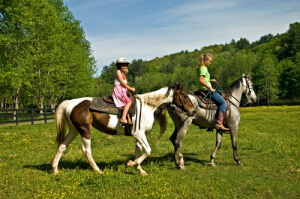Learn How to Ride Horses

Some people associate learning to ride a horse with learning to ride a bike. Both have somewhat similar concepts. Also, once you’ve learned, you won’t forget. Would you like to learn to ride horses?
Learning to ride a horse can be an art. You’ll need skill and concentration. Of course, having a love of horses will make this job a lot easier. Good communication between the horse and its rider is also fundamental.
There’s no specific age for when you can start to learn to ride horses. Really, any time of your life can be the right moment. What’s more important than age is choosing the ideal horse for the rider’s age. With that in mind, you should also take into account the learner’s height and physical makeup.
What about small children? Ponies might be a good place to start. For all other age groups, horses of normal size should be fine.
What should you do when you want to learn to ride horses?
1. Turn to a specialist for help
Before you do anything else, it’s best if you ask for help from a trained professional. Enrolling in a riding school or getting a personal teacher are both good options.

Don’t forget that availability of horses for riding will be an important factor in the process. At established riding schools you’ll be able to find horses that have been trained especially for learners. These horses are ideal for people who have never ridden before, for instance.
2. Use protective equipment
Riding involves risks related to the sport itself and the animals. To avoid serious mishaps, don’t forget to use suitable protective equipment.
One of the indispensable items is a good helmet, especially for children. In case of a tumble, this will help to avoid concussions or other major problems.
Using riding boots is also recommended. These should have a reasonably smooth tread and include a heel to prevent the foot from going completely through the stirrup.
Another important safety measure is knowing how to approach and treat the horse. Horses can take fright easily and may act unpredictably. Whenever you’re dealing with animals, keeping calm is essential.
Here’s another key thing to remember. You should never walk behind the horse or run towards it. Both situations are considered threatening by the horse.
3. Have the right attitude
Like many living creatures, horses can perceive fear and anxiety. Try to be relaxed while you learn how to ride.
Avoid sudden movements, such as throwing yourself off the animal or pulling abruptly on the reins. This won’t just hurt the horse, but it could also cause a violent reaction. Any directions you give the horse should be smooth and controlled.
The rider should be firm in giving commands, but not rough. Maltreating the horse may make it aggressive, like a defense mechanism. Of course, you must listen to the instructor’s recommendations on what to do if the horse gets riled up.
4. Change horses
Always change the horse you ride. In that way, you, as the rider, won’t just get used to one way of riding or one horse’s mannerisms. You’ll improve by interacting with other horses’ styles and temperaments.
Learn to ride: some basic techniques
1. Getting on the horse
To mount, go to the left side of the horse. Next, grab the reins and the pommel (the front of the saddle) with your left hand. With your right hand, grab the back part of the saddle.
Put your left foot in the stirrup and use it to lift yourself upward. Then you have to lift your right leg over the horse’s back, but be careful you don’t hit it on the rump. Once you’re in the saddle, make sure it’s not loose before you move away.
2. Taking the reins
The reins are like your steering wheel to direct the horse where you want to go. If you move the reins towards you slightly, this will tell the horse to move. If you move the reins to one side, the horse will move in that direction. Don’t pull on the reins too tightly or you’ll hurt the horse’s mouth.

Source: ValenciaCaballo
3. Getting the horse to move
To get the horse to move, you should gently press your heels into the horse’s flank. You may find some repeated taps with your heels will help.
It’s common for these actions to be accompanied by verbal commands. ‘Walk’ is used to get the horse to start to move and ‘whoa’ is used to get it to stop.
Throughout the whole process, it’s important to listen to the teacher’s instructions as you learn to ride horses. Your skill as a rider will depend on getting plenty of practice, as well as diligence on your part.
This text is provided for informational purposes only and does not replace consultation with a professional. If in doubt, consult your specialist.